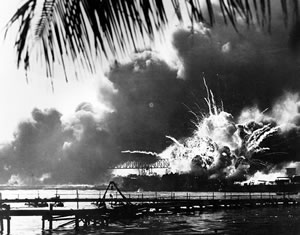
December 7 and September 11
A sunny morning of complete ordinariness suddenly transformed by a lethal surprise from a clear, blue sky. The events of Sept. 11 inescapably seem to parallel the attack on Pearl Harbor. After both surprise attacks, we would discover, painfully, that our national security assumptions were too self-satisfied, too grounded in the belief that we had correctly anticipated the source and the direction of possible threats. In each case we failed to gauge the hostility our own actions had generated, had misjudged the audacity of our assailant.

The USS Shaw explodes during the Japanese attack on Pearl Harbor on Dec. 7, 1941. Department of Defense photo.
In 1941, news of the Japanese attack was slow in reaching thousands of Americans in a time when radios and telephones were in fewer homes than televisions are today. In 2001, the attacks were seen in real time, the country linked electronically to every occurrence, every rumor. But the immediate responses do share some similarities. Shock, anger, fear and a surge of national feeling arose instantly. Both were "sneak attacks" producing demands for vengeance—and regrettable outbursts of abuse and suspicion directed against presumed representatives of "the enemy" within our own borders (Chinese in 1941, Sikhs now, for example). Significantly, where American leadership failed then to defend Japanese residents in the West, in the present crisis it has hurried to denounce racist reactions.
But there are as many differences as similarities. In 1941 the country was already striving to reach a war-footing, conscripting men and churning out ships, planes and munitions at a rapidly rising rate. Most Americans anticipated the outbreak of war very soon—just not at Pearl Harbor in the Pacific. Before Sept. 11, our country was preoccupied with partisan political wrangling in Washington and concerns about the economy. Even today, there has been no call for a national war effort. Moreover, this enemy has a very different agenda from territorial hegemony: sowing terror and paralysis to cripple Western institutions themselves. Unleashing American productivity and energy will not, this time, be a sufficient answer.
In World War II, it gradually became apparent that while the war in the Pacific was going badly at first, and U-boats were ravaging shipping along the Eastern seaboard, any real threat to the United States itself was dwindling daily. Rumors of Japanese carriers standing off the mouth of the Columbia River or of Zero fighters flying over San Francisco quickly disappeared. In fact, America's sacrifice in the war—some 400,000 dead—involved only six civilians within the 48 states. However shaken by Pearl Harbor and the first weeks of the war, Americans were certain who the enemy was, of their determination to gain a total, military defeat of that enemy and of their confidence in final victory by what Winston Churchill would later term "the proper application of overwhelming force."
Today's Americans look with far less certainty on the events under way while sharing the same kind of anger and bitterness as their predecessors. In this conflict, the Home Front is the target. Moreover, "the enemy" remains elusive and the prospect of a protracted, indeterminate kind of conflict pitting Islam against the West in a "clash of civilizations" is sobering. In an open-ended "war against terrorism," victory is not defined by the overthrow of an enemy nation and destruction of its armed forces. Vice President Dick Cheney has cautioned that this war is not like previous wars "in the sense that it may never end. At least not in our lifetime."
Nothing more strikingly separates today's wartime mood from that of World War II than the ambivalence so many Americans are expressing about the very notion of waging war. In 1941 few questioned the necessity of war, much less the moral justness of a cause begun, as F.D.R. had reminded everyone, with "an unprovoked and dastardly attack." Current reactions seem, by comparison, a stew of patriotic zeal, moral anguish and open denunciation of U.S. policy and practice throughout the world. As united as they are in denouncing the slaughter of Sept. 11, Americans are divided about the way to respond. In 1941, we were joining a "Grand Alliance;" a shaky and troubled alliance at all times but one sustained (just) by an unambiguous, shared determination to end the threat posed by the Axis states. We are now in a war on terrorism with an acute sensitivity to global perceptions of the United States. We are part of an amorphous coalition of anti-terrorist states which agrees on very little. Americans are also expressing an unprecedented concern over casualty limitation—ours as well as theirs. Unlike 1941, the matter of means and ends is far from settled.
Finally, we must approach comparisons with a revered past with great care. Nostalgia for World War II—which seems, in the glow of remembrance, a clearer, surer war—only makes our present circumstance more confounding for many Americans. It also obscures the complexity and uncertainty that a previous generation actually lived through at the time, when victory was not certain and the future held many terrors.—Military historian Randolph Hennes, '52, '66, recently retired from his position as associate director of the UW Honors Program.
- Return to Seeing the Unimaginable
- Return to ER on the Streets of New York
- Return to What I Saw: Brooklyn
- Return to The Cal Ripken of His Field
- Return to What I Saw: Ground Zero
- Return to Lifesaving Flight Is Grounded by F-16s
- Return to The Minds of Killers—and Terrorists
- Return to What I Saw: Red Square
- Return to 9/11 Contents
- Return to December 2001 Table of Contents